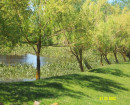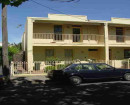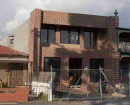Back to search results
VAULT
111 STURT STREET SOUTHBANK, MELBOURNE CITY
VAULT
111 STURT STREET SOUTHBANK, MELBOURNE CITY
All information on this page is maintained by Heritage Victoria.
Click below for their website and contact details.
Victorian Heritage Register
-
Add to tour
You must log in to do that.
-
Share
-
Shortlist place
You must log in to do that.
- Download report
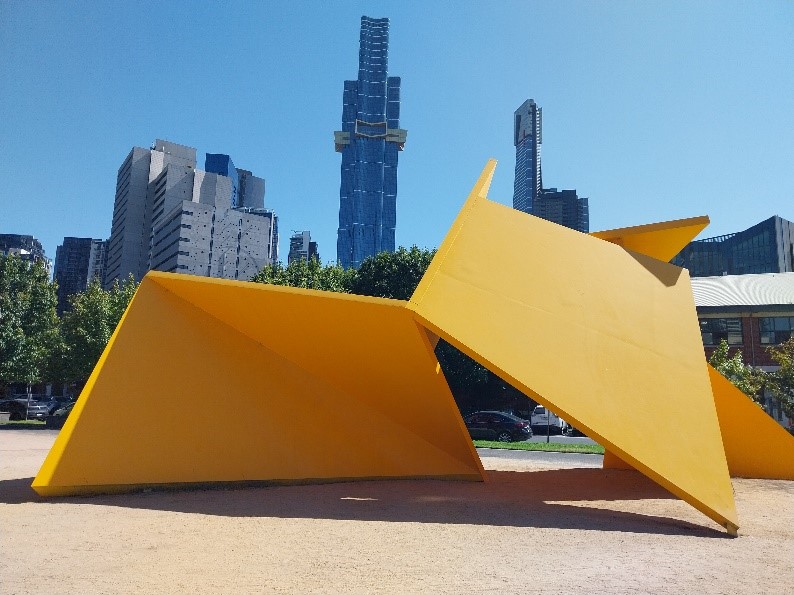
2024 Vault 3

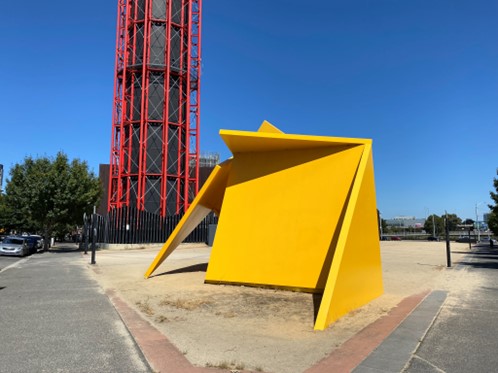
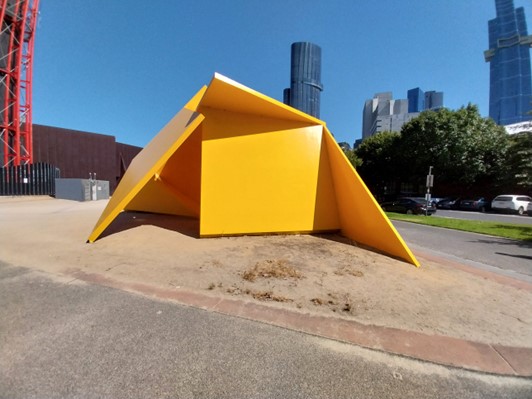
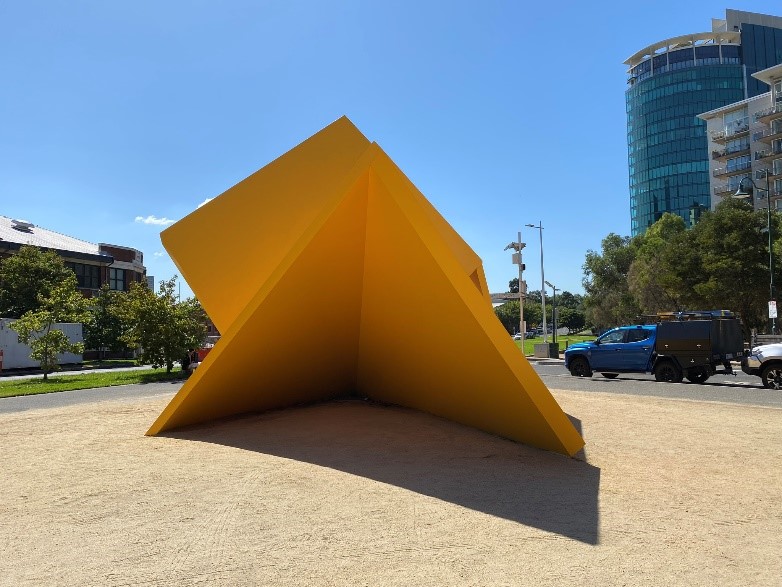
On this page:
Statement of Significance
What is significant?
Vault is a large, abstract sculpture by Ron Robertson-Swann created in 1979-80. It is fabricated from welded steel and is characterised by its substantial scale, angular plates and bright yellow colour.
How is it significant?
Vault is of historical and aesthetic significance to the State of Victoria. It satisfies the following criterion for inclusion in the Victorian Heritage Register:
Criterion A
Importance to the course, or pattern, of Victoria’s cultural history.
Criterion D
Importance in demonstrating the principal characteristics of a class of cultural places and objects
Criterion E
Importance in exhibiting particular aesthetic characteristics.
Criterion A
Importance to the course, or pattern, of Victoria’s cultural history.
Criterion D
Importance in demonstrating the principal characteristics of a class of cultural places and objects
Criterion E
Importance in exhibiting particular aesthetic characteristics.
Why is it significant?
Vault is historically significant as Victoria’s most well-known and controversial example of art commissioned for a public place. Its unveiling in 1980 as part of Melbourne’s new City Square spurred an extraordinary response from critics, politicians, journalists and members of the public across the State. Criticism focussed on its distinctive colour, and the sculpture came to be known by the derogatory name ‘Yellow Peril’. Vault initiated an unprecedented public debate about contemporary art and its role in the public realm. It has become emblematic of both the value of contemporary and abstract art and public resistance to it.
(Criterion A)
Vault is significant as a notable example of public art in Victoria. It is a fine work by renowned Australian sculptor Ron Robertson-Swann and an accomplished work of sculpture. It is a pivotal example, representing a departure from more traditional forms of sculpture commissioned for public places. It has proved to be influential, having been subsequently referenced in multiple artworks, sculptures and works of architecture and design in Victoria.
(Criterion D)
Vault is significant for its distinctive aesthetic characteristics – namely its colour, scale and composition of forms. These characteristics have a high degree of public recognition and critical acclaim. Vault has come to be celebrated as an important example of abstract sculpture in Victoria. It has been recognised by numerous artists, designers and architects via references to its colour and form.
(Criterion E)
Show more
Show less
-
-
VAULT - History
The city square
Towards the end of the 1950s, an area on Swanston Street opposite the Melbourne Town Hall, was identified for a city square. From the late 1960s, plans for the square were formalised and in 1975 a design competition was launched. Architectural practice Denton Corker Marshall was successful. A large, colourful, abstract sculpture was central to Denton Corker Marshall’s plans. It was envisioned that the sculpture could provide a focal point and complement the ‘clean, contemporary lines of their proposed square’. This reflected a worldwide trend to commission contemporary abstract sculptures for squares and plazas. In mid-1977, efforts got underway to identify a sculptor for the project. The artist was to be Australian and ‘representative of the 1970s’. Denton Corker Marshall proposed a limited competition between three notable contemporary sculptors: Ron Robertson-Swann, Clive Murray-White, and David Wilson. Submissions were formally invited in February 1978. In May of that year, Robertson-Swann’s proposal was selected.
Design and approval
When the proposed design was unveiled to assembled Councillors in late 1978, debate began. Some councillors appeared ‘anxious to outdo the other with a disparaging description’. Councillor Don Osborne was vociferous in his criticism, and soon proposed that the council rescind its approval of the sculpture. He promoted his views in the Sun newspaper in colourful terms. Councillor Irvin Rockman, then Lord Mayor, chastised other councillors for their conservatism in the Age and Herald. The Australian Guild of Realist Artists and Victorian Artists Society shared critical views of the proposed sculpture, framing the debate as a battle between ‘traditional’ and ‘modern’ art. The sculpture was again debated at council meetings in February and March 1979, where it was described in derogatory terms as looking like ‘abandoned farm machinery’ or ‘left-over air conditioning equipment’. Nonetheless, the proposal was approved, and Denton Corker Marshall was instructed to proceed. Over these months of debate, the controversy had consistently appeared on the front page of major Victorian newspapers. Members of the public joined the debate via the letter pages of major newspapers, with artists, critics, educators and gallery owners coming to the defence of Robertson-Swann.
Fabrication
In early 1979, development work on the sculpture commenced, during which Robertson-Swann worked closely with engineering firm Woolacott Hale Corlett & Jumikis on approaches to fabrication. Stanley Welding and Fabrications Ltd fabricated the sculpture. On 1 May 1980, installation of the sculpture in the square began. It was painted its distinctive yellow on 10-11 May 1980.
Installation and reaction
Later that month, Queen Elizabeth formally opened the new square. The sculpture differed from traditional sculptures commissioned for public places in almost every way. Max Delaney, artistic director of ACCA, has commented that ‘it was a much larger sculpture than we’d ever experienced, it was designed so members of the community could walk through, within and around.’ Its bright yellow colour became its distinguishing feature, and following its unveiling, Councillor Osborne and others began referring to it as ‘Yellow Peril’ – a derogatory term used to refer to Asian migrants to Australia. Moves were soon underway to have it moved from the square, and again, vigorous public debate ensued. Some were suspicious of the $70,000 paid for the work. Others supported the sculpture for ably responding to the brief, exposing the public to contemporary art and for ‘the sheer fun of the thing.’ The sculpture was the subject of a five-hour debate at a Council meeting in July 1980, during which the council ultimately voted to move it. Extensive statewide media coverage followed, as did protests, petitions and campaigns defending the sculpture. Delaney has observed that ‘it became a staple of the front pages of Melbourne’s newspapers for six months or so…it kept cartoonists employed for months’. In mid-1981, Norm Gallagher and the Builders Labourers Federation announced they would impose a ban on dismantling the sculpture. Tony Ellwood, Director of the NGV, has noted that ‘few Australian works of art have generated as much debate as that which surrounded the unveiling of Robertson-Swann’s monumental, steel, sculptural assemblage’. Writing in the Sydney Morning Herald, Ray Edgar reflected that ‘in the cultural philistinism it unearthed, Vault is Melbourne's Blue Poles, its Sydney Opera House.’
Subsequent locations
In July 1981, Vault, as it was then known, was relocated to Batman Park on the northern bank of the Yarra River in a much less visible and frequented location. It was regularly vandalised and suffered from neglect. In the late 1990s, plans were underway for the construction of the Australian Centre for Contemporary Art (ACCA) and it was felt Vault would be a good addition to the gallery forecourt. Vault remained in Batman Park until 2002 when it was dismantled and re-erected in its new location with the support of the artist. It remains in this location.
Recognition and influence
Recognition of Vault has grown and solidified in the ensuing decades. Delaney has observed that ‘Vault is like a weathervane for the way people express views about the shape of the city, our values as a community and our vision for the future…it’s been widely influential and the subject of numerous homages.’ The Survey of Post-War Built Heritage in Victoria prepared for Heritage Victoria in 2008 identified Vault as ‘Victoria’s most famous and controversial piece of public art.’ In 2017, it was identified in the Southbank and Fishermans Bend Heritage Review prepared by Biosis for the City of Melbourne, and subsequently a heritage overlay was applied. It has become a recurring motif in the work of artists, architects and designers, and references to the work are found in Ashton Raggatt McDougall’s redesign for Storey Hall at RMIT and multiple other proposed works by the practice, the entrance to Monash Art Design and Architecture designed by Lyons Architecture, Denton Corker Marshall’s design for the Melbourne International Gateway on CityLink, artist Emily Floyd’s sculpture Public Art Strategy commissioned for the Eastlink Freeway and designs for Melbourne City Council’s revamped tram stops produced in 2012. It is featured in an installation video work Yellow Peril by Eugenia Lim and a poem by Angela Brennan.
Ron Robertson-Swann
Ron Robertson-Swann is a Sydney-based sculptor best known for his abstract metal sculptures. He undertook studies at both the National Art School, Sydney, and St Martins School of Art, London where he also worked as an assistant to sculptor Henry Moore. Robertson-Swann’s approach differed to Moore’s largely figurative bronze work, and was influenced by Anthony Caro, known for his use of geometric forms and use of steel. His first solo exhibition was held in 1968; numerous solo exhibitions both in Australia and internationally followed. He was amongst the young and emerging artists included in the renowned exhibition ‘The Field’ held at the National Gallery of Victoria and Art Gallery of New South Wales in 1968. He has completed several major public commissions, including a work for the Queensland Cultural Centre, though Vault remains the work for which he is best known. He has received awards including the Transfield Art Prize, Comalco Invitational Sculpture Award, Mildura Purchase Prize, the Bathurst Prize and the Alice Prize. He is also an educator and was Head of Sculpture at the Canberra School of Art and National Art School. He was a founding member of the Visual Arts Board of the Australia Council.
Selected bibliography
‘Hidden Vault: Tributes to 'Yellow Peril' sculpture found in public places across Melbourne’, ABC News, 5 April 2016, www.abc.net.au/news/2016-04-05/vault-yellow-peril-sculpture-tributes-scattered-across-melbourne/7248702.
Edgar, Ray. ‘From Yellow Peril to pure gold. 40 years on, Vault has been vindicated’, Sydney Morning Herald, 26 March 2018.
Malloy, Susan. ‘The Moving Story of a Grand Folly’, The Bulletin, 23 October 1984.
O’Brien, Kerrie, ‘Four Decades on, the controversial Vault has won hearts’, Age, 28 July 2020.
Biosis, Southbank and Fishermans Bend Heritage Review, 2017.
Heritage Alliance, Survey of Post-War Built Heritage in Victoria: Stage One, 2008.
Sparrow, Jeff and Jill Sparrow, Radical Melbourne 2: The Enemy Within, Carlton North, Vic: Vulgar Press, 2004.
Wallis, Geoffrey J., Peril in the Square: The sculpture that challenged a city, Briar Hill, Victoria: Indra Publishing, 2004.
Consultation and interviews
Thank you to Ron Robertson-Swann and Eddie Butler-Bowden of Melbourne City Council for their assistance in preparing this recommendation.
VAULT - Permit Exemptions
General Exemptions:General exemptions apply to all places and objects included in the Victorian Heritage Register (VHR). General exemptions have been designed to allow everyday activities, maintenance and changes to your property, which don’t harm its cultural heritage significance, to proceed without the need to obtain approvals under the Heritage Act 2017.Places of worship: In some circumstances, you can alter a place of worship to accommodate religious practices without a permit, but you must notify the Executive Director of Heritage Victoria before you start the works or activities at least 20 business days before the works or activities are to commence.Subdivision/consolidation: Permit exemptions exist for some subdivisions and consolidations. If the subdivision or consolidation is in accordance with a planning permit granted under Part 4 of the Planning and Environment Act 1987 and the application for the planning permit was referred to the Executive Director of Heritage Victoria as a determining referral authority, a permit is not required.Specific exemptions may also apply to your registered place or object. If applicable, these are listed below. Specific exemptions are tailored to the conservation and management needs of an individual registered place or object and set out works and activities that are exempt from the requirements of a permit. Specific exemptions prevail if they conflict with general exemptions. Find out more about heritage permit exemptions here.Specific Exemptions:The works and activities below are not considered to cause harm to the cultural heritage significance of the Vault subject to the following guidelines and conditions:
Guidelines
1. Where there is an inconsistency between permit exemptions specific to the registered place or object (‘specific exemptions’) established in accordance with either section 49(3) or section 92(3) of the Act and general exemptions established in accordance with section 92(1) of the Act specific exemptions will prevail to the extent of any inconsistency.
2. In specific exemptions, words have the same meaning as in the Act, unless otherwise indicated. Where there is an inconsistency between specific exemptions and the Act, the Act will prevail to the extent of any inconsistency.
3. Nothing in specific exemptions obviates the responsibility of a proponent to obtain the consent of the owner of the registered place or object, or if the registered place or object is situated on Crown Land the land manager as defined in the Crown Land (Reserves) Act 1978, prior to undertaking works or activities in accordance with specific exemptions.
4. If a Cultural Heritage Management Plan in accordance with the Aboriginal Heritage Act 2006 is required for works covered by specific exemptions, specific exemptions will apply only if the Cultural Heritage Management Plan has been approved prior to works or activities commencing. Where there is an inconsistency between specific exemptions and a Cultural Heritage Management Plan for the relevant works and activities, Heritage Victoria must be contacted for advice on the appropriate approval pathway.
5. Specific exemptions do not constitute approvals, authorisations or exemptions under any other legislation, Local Government, State Government or Commonwealth Government requirements, including but not limited to the Planning and Environment Act 1987, the Aboriginal Heritage Act 2006, and the Environment Protection and Biodiversity Conservation Act 1999 (Cth). Nothing in this declaration exempts owners or their agents from the responsibility to obtain relevant planning, building or environmental approvals from the responsible authority where applicable.
6. Care should be taken when working with heritage buildings and objects, as historic fabric may contain dangerous and poisonous materials (for example lead paint and asbestos). Appropriate personal protective equipment should be worn at all times. If you are unsure, seek advice from a qualified heritage architect, heritage consultant or local Council heritage advisor.
7. The presence of unsafe materials (for example asbestos, lead paint etc) at a registered place or object does not automatically exempt remedial works or activities in accordance with this category. Approvals under Part 5 of the Heritage Act 2017 must be obtained to undertake works or activities that are not expressly exempted by the below specific exemptions.
8. All works should be informed by a Conservation Management Plan prepared for the place or object. The Executive Director is not bound by any Conservation Management Plan and permits still must be obtained for works suggested in any Conservation Management Plan.
Conditions
1. All works or activities permitted under specific exemptions must be planned and carried out in a manner which prevents harm to the registered place or object.?Harm includes moving, removing or damaging any part of the registered place or object that contributes to its cultural heritage significance.
2. If during the carrying out of works or activities in accordance with specific exemptions original or previously hidden or inaccessible details of the registered place are revealed relating to its cultural heritage significance, including but not limited to historical archaeological remains, such as features, deposits or artefacts, then works must cease and Heritage Victoria notified as soon as possible.
3. If during the carrying out of works or activities in accordance with specific exemptions any Aboriginal cultural heritage is discovered or exposed at any time, all works must cease and the Secretary (as defined in the Aboriginal Heritage Act 2006) must be contacted immediately to ascertain requirements under the Aboriginal Heritage Act 2006.
4. If during the carrying out of works or activities in accordance with specific exemptions any munitions or other potentially explosive artefacts are discovered, Victoria Police is to be immediately alerted and the site is to be immediately cleared of all personnel.
5. If during the carrying out of works or activities in accordance with specific exemptions any suspected human remains are found the works or activities must cease. The remains must be left in place and protected from harm or damage. Victoria Police and the State Coroner’s Office must be notified immediately. If there are reasonable grounds to believe that the remains are Aboriginal, the State Emergency Control Centre must be immediately notified on 1300 888 544, and, as required under s.17(3)(b) of the Aboriginal Heritage Act 2006, all details about the location and nature of the human remains must be provided to the Secretary (as defined in the Aboriginal Heritage Act 2006.
Exempt works and activities
1. All maintenance, conservation and repair works in keeping with City of Melbourne policies, guidelines, contracts and related documents.
-
-
-
-
-
FLINDERS STREET RAILWAY STATION COMPLEX
 Victorian Heritage Register H1083
Victorian Heritage Register H1083 -
COMMERCIAL TRAVELLERS ASSOCIATION BUILDING
 Victorian Heritage Register H0934
Victorian Heritage Register H0934 -
QUEENS BRIDGE
 Victorian Heritage Register H1448
Victorian Heritage Register H1448
-
194 Albion Street, Brunswick
 Merri-bek City
Merri-bek City -
194A Albion Street, Brunswick
 Merri-bek City
Merri-bek City
-
-




